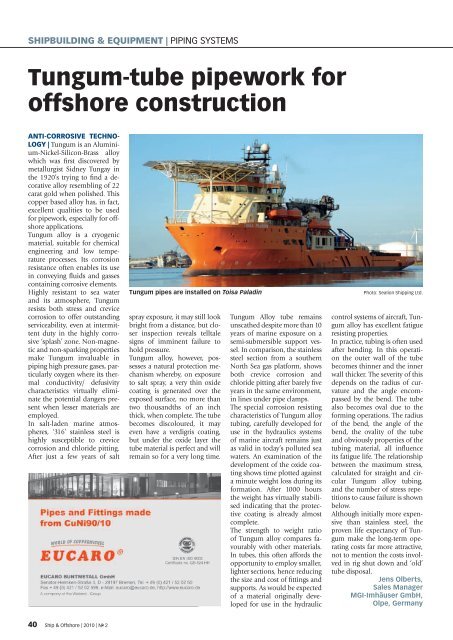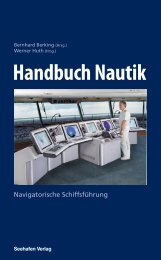| 2 | 2010 - Schiff & Hafen
| 2 | 2010 - Schiff & Hafen
| 2 | 2010 - Schiff & Hafen
You also want an ePaper? Increase the reach of your titles
YUMPU automatically turns print PDFs into web optimized ePapers that Google loves.
SHIPBUILDING & EQUIPMENT | PIPING SYSTEMS<br />
Tungum-tube pipework for<br />
offshore construction<br />
ANTI-CORROSIVE TECHNO-<br />
LOGY | Tungum is an Aluminium-Nickel-Silicon-Brass<br />
alloy<br />
which was fi rst discovered by<br />
metallurgist Sidney Tungay in<br />
the 1920’s trying to fi nd a decorative<br />
alloy resembling of 22<br />
carat gold when polished. This<br />
copper based alloy has, in fact,<br />
excellent qualities to be used<br />
for pipework, especially for offshore<br />
applications.<br />
Tungum alloy is a cryogenic<br />
material, suitable for chemical<br />
engineering and low temperature<br />
processes. Its corrosion<br />
resistance often enables its use<br />
in conveying fl uids and gasses<br />
containing corrosive elements.<br />
Highly resistant to sea water<br />
and its atmosphere, Tungum<br />
resists both stress and crevice<br />
corrosion to offer outstanding<br />
serviceability, even at intermittent<br />
duty in the highly corrosive<br />
‘splash’ zone. Non-magnetic<br />
and non-sparking properties<br />
make Tungum invaluable in<br />
piping high pressure gases, particularly<br />
oxygen where its thermal<br />
conductivity/ defusivity<br />
characteristics virtually eliminate<br />
the potential dangers present<br />
when lesser materials are<br />
employed.<br />
In salt-laden marine atmospheres,<br />
‘316’ stainless steel is<br />
highly susceptible to crevice<br />
corrosion and chloride pitting.<br />
After just a few years of salt<br />
40 Ship & Offshore | <strong>2010</strong> | N o 2<br />
Tungum pipes are installed on Toisa Paladin Photo: Sealion Shipping Ltd.<br />
spray exposure, it may still look<br />
bright from a distance, but closer<br />
inspection reveals telltale<br />
signs of imminent failure to<br />
hold pressure.<br />
Tungum alloy, however, possesses<br />
a natural protection mechanism<br />
whereby, on exposure<br />
to salt spray, a very thin oxide<br />
coating is generated over the<br />
exposed surface, no more than<br />
two thousandths of an inch<br />
thick, when complete. The tube<br />
becomes discoloured, it may<br />
even have a verdigris coating,<br />
but under the oxide layer the<br />
tube material is perfect and will<br />
remain so for a very long time.<br />
Tungum Alloy tube remains<br />
unscathed despite more than 10<br />
years of marine exposure on a<br />
semi-submersible support vessel.<br />
In comparison, the stainless<br />
steel section from a southern<br />
North Sea gas platform, shows<br />
both crevice corrosion and<br />
chloride pitting after barely fi ve<br />
years in the same environment,<br />
in lines under pipe clamps.<br />
The special corrosion resisting<br />
characteristics of Tungum alloy<br />
tubing, carefully developed for<br />
use in the hydraulics systems<br />
of marine aircraft remains just<br />
as valid in today’s polluted sea<br />
waters. An examination of the<br />
development of the oxide coating<br />
shows time plotted against<br />
a minute weight loss during its<br />
formation. After 1000 hours<br />
the weight has virtually stabilised<br />
indicating that the protective<br />
coating is already almost<br />
complete.<br />
The strength to weight ratio<br />
of Tungum alloy compares favourably<br />
with other materials.<br />
In tubes, this often affords the<br />
opportunity to employ smaller,<br />
lighter sections, hence reducing<br />
the size and cost of fi ttings and<br />
supports. As would be expected<br />
of a material originally developed<br />
for use in the hydraulic<br />
control systems of aircraft, Tungum<br />
alloy has excellent fatigue<br />
resisting properties.<br />
In practice, tubing is often used<br />
after bending. In this operation<br />
the outer wall of the tube<br />
becomes thinner and the inner<br />
wall thicker. The severity of this<br />
depends on the radius of curvature<br />
and the angle encompassed<br />
by the bend. The tube<br />
also becomes oval due to the<br />
forming operations. The radius<br />
of the bend, the angle of the<br />
bend, the ovality of the tube<br />
and obviously properties of the<br />
tubing material, all infl uence<br />
its fatigue life. The relationship<br />
between the maximum stress,<br />
calculated for straight and circular<br />
Tungum alloy tubing,<br />
and the number of stress repetitions<br />
to cause failure is shown<br />
below.<br />
Although initially more expensive<br />
than stainless steel, the<br />
proven life expectancy of Tungum<br />
make the long-term operating<br />
costs far more attractive,<br />
not to mention the costs involved<br />
in rig shut down and ‘old’<br />
tube disposal.<br />
Jens Olberts,<br />
Sales Manager<br />
MGI-Imhäuser GmbH,<br />
Olpe, Germany



